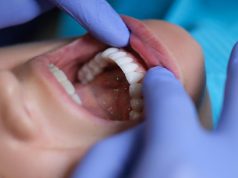Tool validated in patients treated for oral cavity squamous cell carcinoma
FRIDAY, Oct. 16, 2015 (HealthDay News) — A statistical tool can accurately estimate an individual patient’s risk of developing a major complication after surgery for oral cavity squamous cell carcinoma, according to a study published online Oct. 15 in JAMA Otolaryngology-Head & Neck Surgery.
Mahmoud I. Awad, M.D., from Memorial Sloan Kettering Cancer Center in New York, and colleagues retrospectively reviewed 506 previously untreated adult cases with biopsy-proven oral cavity squamous cell carcinoma who underwent surgery between Jan. 1, 2007, and Dec. 31, 2012. Patients treated between Jan. 1, 2009, and Dec. 31, 2012 made up the modeling cohort (354 patients) and were used to develop a nomogram to predict the risk of developing a major postoperative complication. The nomogram was validated in patients treated between Jan. 1, 2007, and Dec. 31, 2008 (152 patients).
The researchers found that clinical characteristics were similar between the cohorts. Major postoperative complications were seen in 36 patients in the modeling cohort (10.2 percent) and 16 patients in the validation cohort (10.5 percent). The nomogram included the six preoperative variables with the highest individual predictive value (body mass index, comorbidity status, preoperative white blood cell count, preoperative hematocrit, planned neck dissection, and planned tracheotomy). The nomogram predicted a major complication with a validated concordance index of 0.79. The nomogram maintained predictive accuracy with the inclusion of surgical operative variables (concordance index, 0.77).
“This study provides proof of principle that nomograms can allow clinicians to anticipate which patients are at higher risk of developing complications after surgery, thereby facilitating timely recognition and effective management of postoperative complications,” conclude the authors.
Copyright © 2015 HealthDay. All rights reserved.








